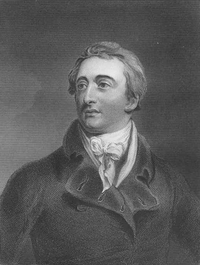Lord William Bentinck | |
|---|---|
 Lord William Bentinck, painting by Thomas Lawrence | |
| Governor-General of India | |
| In office 22 April 1834 – 20 March 1835 | |
| Monarch | William IV |
| Prime Minister | |
| Succeeded by | Sir Charles Metcalfe (As Acting Governor-General) |
| Governor-General of the Presidency of Fort William | |
| In office 4 July 1828 – 22 April 1833 | |
| Monarchs | |
| Prime Minister | |
| Preceded by | William Butterworth Bayley (Acting Governor-General) |
| Governor of Madras | |
| In office 30 August 1803 – 11 September 1807 | |
| Monarch | George III |
| Prime Minister | |
| Preceded by | The 2nd Baron Clive |
| Succeeded by | William Petrie (Acting Governor) |
| Personal details | |
| Born | 14 September 1774 Buckinghamshire, England |
| Died | 17 June 1839 (aged 64) Paris, France |
| Political party | Whig |
| Spouse |
Lady Mary Acheson (m. 1803) |
| Parents | |
| Education | Westminster School |
| Awards | |
| Military service | |
| Branch/service | British Army |
| Years of service | 1791–1839 |
| Rank | Lieutenant-General |
| Commands | |
| Battles/wars | Napoleonic Wars |
Lieutenant General Lord William Henry Cavendish-Bentinck GCB GCH PC (14 September 1774 – 17 June 1839), known as Lord William Bentinck, was a British military commander and politician who served as the governor of Fort William (Bengal) from 1828 to 1834 and the first governor-general of India from 1834 to 1835.
He has been credited for significant social and educational reforms in India, including abolishing sati, forbidding women to witness the cremations on the ghats of Varanasi,[1] suppressing female infanticide and human sacrifice.[2] Bentinck said, "the dreadful responsibility hanging over his head in this world and the next, if… he was to consent to the continuance of this practice (sati) one moment longer." Bentinck after consultation with the army and officials passed the Bengal Sati Regulation, 1829.[3] The challenge came from the Dharma Sabha which appealed in the Privy Council, however the ban on Sati was upheld.[4] He reduced lawlessness by eliminating thuggee – which had existed for over 450 years – with the aid of his chief captain, William Henry Sleeman. Along with Thomas Babington Macaulay he introduced English as the language of instruction in India.[5][6][7][8] Mysore was annexed under his presidency.[9][10]
- ^ Padmashri Dr Meenakshi Jain; interview with Debdas Mukhopadhyay, 29 febr 2020
- ^ Showick Thorpe Edgar Thorpe (2009). The Pearson General Studies Manual 2009, 1/e. Pearson Education India. pp. 103–. ISBN 978-81-317-2133-9. Retrieved 2 May 2018.
- ^ John Clark Marshman (18 November 2010). History of India from the Earliest Period to the Close of the East India Company's Government. Cambridge University Press. pp. 357–. ISBN 978-1-108-02104-3. Retrieved 7 May 2020.
- ^ S. Muthiah (2008). Madras, Chennai: A 400-year Record of the First City of Modern India. Palaniappa Brothers. pp. 484–. ISBN 978-81-8379-468-8. Retrieved 7 May 2020.
- ^ Radhey Shyam Chaurasia (2002). History of Modern India, 1707 A. D. to 2000 A. D. Atlantic Publishers & Dist. pp. 113–127. ISBN 978-81-269-0085-5. Retrieved 2 May 2018.
- ^ Jörg Fisch (2000). "Humanitarian Achievement or Administrative Necessity? Lord William Bentinck and the Abolition of Sati in 1829". Journal of Asian History. 34 (2): 109–134. JSTOR 41933234.
- ^ Arvind Sharma; Ajit Ray (1988). Sati: Historical and Phenomenological Essays. Motilal Banarsidass. pp. 7–9. ISBN 978-81-208-0464-7. Retrieved 2 May 2018.
- ^ Spear, Percival (1938). "Bentinck and Education". Cambridge Historical Journal. 6 (1): 78–101. doi:10.1017/S1474691300003814. ISSN 1474-6913. JSTOR 3020849.
- ^ Rice, B.L. (1897). Mysore. A Gazetteer Compiled for Government. Revised Edition. Volume 1. London: Archiband Constable and Company.
- ^ "Lord William Bentinck | British government official". Encyclopædia Britannica. Retrieved 30 May 2019.